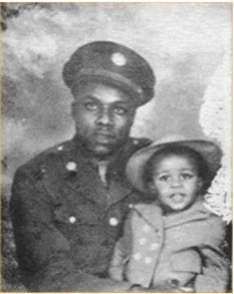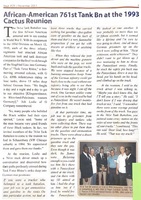Black Service Members of Camp Howze
Very few photographs or names of Black service members stationed at Camp Howze could be found and verified. We hope visitors to this site will spread the word about the Camp Howze Museum, and its collection of artifacts will grow as people connect with its story.
Staff Sergeant Charlie David Mitchell served in WWII as a member of the U.S. Army Service Force's 3918th Quartermaster Gasoline Supply Company. In his oral history video produced by the Library of Congress' Veteran's History Project he discussed his experience supplying fuel to General George S. Patton's 761st Tank Battalion under the 103rd Division in Europe. SSgt. Mitchell remained in the U.S. Army and served in both the Korean War and Vietnam War. He retired after 23 years of service.
In his interview, SSgt. Mitchell shared his memories of being a member of the fuel supply company featured in this article and represented by a few of the veterans in the bottom right photo. Though he is not in the photo, SSgt. Mitchell's description of his role in the "Task Force Rhine" event mentioned in the article provided a link to several more Black soldiers attached to the 761st Tank Battalion under the 103rd Division. Unfortunately, this article does not clearly identify the members though they were likely stationed at Camp Howze along with SSgt. Mitchell prior to their deployment overseas.
Dr. Rothacker Childs Smith (Private First Class Smith in 1943) was transferred from Camp Stewart, GA, to an Army camp he did not name, located in Texas, before being stationed at Camp Howze for two months as a medic. In his memoir, he attributed his initial transfer from Camp Stewart to the lynching of a fellow Black soldier and his "white" French-Canadian wife while they waited to board a bus for Savannah. Although Dr. Smith was in El Paso, TX for surgical technician training during the incident, he and others in his non-combat unit were punished nonetheless for the reaction of other Black soldiers to the couple's murder.
Regarding his time at Camp Howze, he recalled traveling via the local rail line to Fort Worth and then bus to Dallas to attend the nearest segregated Seventh-day Adventist church. During one of his trips, he remembered vividly being verbally abused by a racist bus driver who insisted Pfc. Smith remained standing by the driver until all "white" passengers seated on the backbench were gone.
In contrast, he fondly recalled having the opportunity to eat and converse with the World Heavyweight Boxing Champion, Staff Sergeant Joe Louis Barrow (a.k.a. Joe Louis), during the champ's Thanksgiving visit to Camp Howze.
After Camp Howze, he was sent to Fort Huachuca, AZ and assigned to the 92nd Division and its famed, all-Black, 366th Infantry Regiment. He shared memories of his experiences as a Buffalo Soldier during the war, including his capture in Italy and time spent in Austria and Germany as a prisoner of war until he and his fellow prisoners were liberated by American troops led by General George S. Patton. In 2015 his story was added to the National World War II Museum's collection of veterans' oral histories.
In the last paragraph of the final chapter of Poker Games, Pillow Shams, and Parched Prairies, Betty Stephenson's short book about the history of Camp Howze, one Black soldier was mentioned by name -- Cleveland Captain. Ms. Stephenson wrote that he was sent from a camp in Louisiana to Camp Howze for basic training. She stated that he was assigned to infantry but did not list his unit or job assignment. Once he completed basic training, he was sent to Waco, TX, rather than overseas. After marrying local Gainesville resident Minnie Cain, he changed his plans to move back to Louisiana and settled in Gainesville, TX.








